
The 'Aerial Target' and 'Aerial Torpedo' in GermanyFieseler
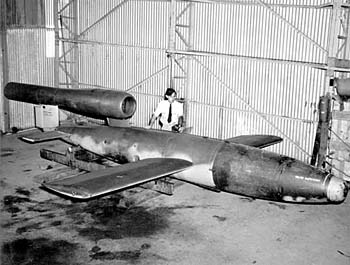 Corporal W. Grundy of Semaphore, South Australia standing beside a captured Fieseler Fi 103, FZG 76 at Laverton, RAAF base, Victoria, Australia
The Argus Newspaper. Reproduction rights owned by the State Library of Victoria.
Fieseler Vergeltungswaffe V1 The FZG-76 was more commonly known as the "V-1" (Vergeltungswaffe 1 -- Vengeance Weapon 1) missile. It was a pilotless, mid-win monoplane powered by a unique pulsating flow duct motor, carrying a warhead weighing 1870lb. Research and development of the missile was initiated in June 1942 by the Luftwaffe, which viewed the cruise missile as a pilot-less plane, at the Research Station in Peenemünde. The project was carefully planned so the product could be easily and cheaply mass-produced. Almost no strategic material was needed; mild steel and wood made up the construction, and weight-saving was of little concern. The missile weighed 4858lb, and could carry 150 gallons of fuel. Guidance and accuracy were pre-programmed into the missile before firing and this prevented the missile from any form of electronic interference or jamming. The path of the missile would always be a straight line. When target was reached the pulse jet simply shut off and the missile began its free-fall. Launching took place on a fixed, sloped ramp about 50 yards in length, utilizing a piston mechanism (like the steam catapults on carriers) to haul the missile into thin air at a speed large enough to keep the missile flying. Launch velocity was about 200mph, and the speed increased to an average of 350mph when the pulse jet took over. The missile could reach an altitude between 3,500 to 4,000 feet, and this made it especially difficult for British anti-aircraft defence since it was too low for the heavy guns and too high for light ones to engage effectively. Only when the automatic power control was used could the British guns shoot down the V-1 successfully. The maximum range was about 130 miles, and at this range about 80% of the projectiles would land within an eight-mile circle of the intended target; not too bad for the contemporary technology (sometimes even better than night-bombing). Mass production began in March 1944 and approximately 35,000 were constructed before the end of the war. Of the 35,000, 9,251 were used against England (London in particular), of which 4,621 were shot down, and 6,551 landed on Antwerp, of which 2,455 were destroyed.
The German V1 flying bomb, or 'buzz' bomb, known originally as the Fieseler Fi 103, FZG 76, was the first of the Vergeltungswaffen ("weapons of vengeance," named in response to Allied air assaults on Germany during World War II). It emerged from proposals made in 1939 by the Argus Motorenwerke. The first V1 test flight was made over the Peenemünde range in December 1941. The project was given high priority by the German High Command in 1942, with Fieseler Flugeugbau Firm, in Kassel, taking the leading development role. The V1 weighed 2,180 kg (4,806 lb), including the gasoline fuel and an 850-kg (1,874-lb) warhead. Powered by a pulse-jet engine producing 300 kg (660 lb) of thrust and mounted above the rear of the fuselage, the V1 was actually a small, pilotless aircraft having an overall length of 7.9 m (25.9 ft) and a wingspan of 5.3 m (17.3 ft). The speed range was 563 to 644 km/h (350 to 400 mph). The V1 was used to attack London from sites near Calais, France, beginning in June 1944. More than 8,000 V1s were launched against London alone. Ramp-launched by a hydrogen peroxide catapult, the V1 could fly an average of 240 km (150 mi). At the end of a preset range, it was put into a dive and the engine cut out, giving the populace only a few seconds during which to take cover. Kenneth Gatland
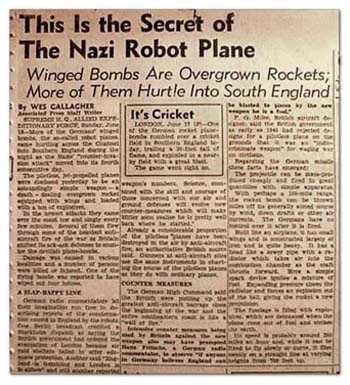 San Francisco Chronicle reports V1 attacks on Britain, 1944 image found on recent eBay auction Download a 500pixel version
V1 Unguided Flying Bomb http://www.accessweb.com/users/mconstab/v1.htm The V1 (known to the Germans as a FZG-76 as it was designed by the Fiesler company) was an unmanned, un-guided, flying bomb. It was a simple concept, but a radical one. The Germans designed a liquid fuelled, pulse-jet drone aircraft that could carry a 2,000 lb warhead to southern England. They overcame the problem of unmanned navigation by simply pointing it in the correct direction, setting some simple gyrocompasses to keep it level and putting just enough fuel in it to get it to their target, typically a city in southern England. They didn't much care what the rocket hit. It was a terror weapon. And it worked. The Germans called it "Vergeltungswaffe" or "retaliation weapon"... more
Development of reaction-propulsion by the Germans for eventual application to military uses was started soon after WWI to evade the terms of the Treaty of Versailles which forbade Germany to develop certain classes of internal-combustion reciprocating motors. Little is known of the progress of these experiments, but shortly before WWII the Germans evolved the principles embodied in the reaction-propulsion unit fitted to the V1 Flying Bomb. Soon after this, the Flying Bomb itself was designed...more
The prototype of the Vergultungswaffen 1 (Revenge Weapon 1 or "V1") was developed by the Gerhard Fieseler Werke GmbH. The Fi 103, as the prototype was designated, differed in several respects from the ultimate production FZG 76. The tail unit was of the cruciform type and the vertical fin equally disposed above and below the body. There was also a vertical stabilising surface above the body in line with the wings. The power unit of the FZG 76 was an Argus development, its full designation being 109.014 or, more generally, As 014....more
The Fieseler Fi 103R manned missile was one of the many desperate projects conceived as the German situation became more hopeless. Basically the Fi 103R was a piloted version of the V-1 flying bomb, powered by the same Argus pulsejet engine. By mid-1944, preparations had been made for mass production, in time for the operation to attack the Allied forces amassed in southern England. The Fi 103R was to be carried by a parent aircraft and released near the target. Then the pilot would take over and direct the bomb into a dive towards the target. The pilot was to detach the canopy and bale out just before impact. The canopy, however, would almost certainly block the pulsejet inlet and reduce the chance of pilot survival to almost zero. Nevertheless, the Germans went to great lengths to distinguish their Selbstopfermänner (self-sacrifice men) from the Japanese Kamikaze pilots, whose cockpits were sealed closed before take-off. The Fi 103R's operation was codenamed Reichenberg and a total of about 175 manned Fi 103Rs (R for Reichenberg) were made. The R-I, R-II and R-III were used for test and training, and R-IV was to be the production model. Two Rechlin pilots crashed while test-flying the Fi 103R, and afterwards trial flights were transferred to DFR test pilots Hanna Reitsch and Heinz Kensche. Flying the Fi 103R was quite simple, since the Fi 103R's unmanned version could fly without direct control. Landing, on the other hand, was very difficult due to the primitive control system, absence of landing gear and high landing speed. This should not have mattered much because the Fi 103R was not designed to return anyway! The project never took off, due to the Germany high command's apathy, even though some 70 pilots volunteered for training.
Excerpts The history of the German Luftwaffe in World War II has been examined by scores of authors and eyewitnesses. The case of Kampfgeschwader (Battle Wing) 200, or KG 200, is a different story, however. The real story of this special Luftwaffe unit has remained shrouded in mystery, and most members maintained their silence after the war. The commander of the unit, Colonel Werner Baumbach, a winner of the Knight's Cross and a celebrated Junkers Ju-88 bomber pilot, did not even mention KG 200 in his memoirs, Broken Swastika KG 200 was a unique unit, which operated a wide variety of aircraft--from the Blohm und Voss Bv-222 Wiking (the largest flying boat of the era) to the Junkers Ju-52, Ju-90, Ju-290 and Ju-188, the Heinkel He-111, and even captured British and American aircraft such as the Consolidated B-24 Liberator and the Boeing B-17 Flying Fortress. [...] The first two groups of KG 200 were the only ones ever fully developed, although several other projects were planned. III/KG 200 was to have fitted Focke-Wulf Fw-190 fighters with torpedoes but was never inaugurated. IV/KG 200 was the training and replacement group for KG 200 and trained the nearly 100 "self-sacrifice" pilots who flew the Reichenberg modified V-1 suicide weapons. KG 100, which handled Fritz X and Hs 293 guided missiles, was also associated with KG 200. The fifth long-range reconnaissance group flew Ju-90s and Ju-290s on their missions. The test unit of the Luftwaffe commander flew high-altitude reconnaissance and testing aircraft and also conducted evaluation flights of captured Allied aircraft. [...] KG 200 was also in charge of the German suicide pilots. The Germans mirrored the Japanese kamikaze efforts with the Reichenberg IV suicide bomb. The concept was developed by a glider pilot who was a veteran of the famous 1940 assault on the Belgian fortress of Eben Emael. As the war turned against Germany and his fellow pilots were slaughtered, he thought that if glider pilots were to be sent to perish, they should be armed with a suitable weapon to bloody the enemy. The Reichenbergs were to be piloted by "self-sacrifice men." Thousands of men volunteered for vaguely defined "special operations," and 70 of them were sent to KG 200. Although these men were trained on gliders, they were to fly a manned variant of the V-1 buzz bomb. The V-1, also known as the Fiesler Fi-103, was already in mass-production for its primary purpose as a flying bomb. The German Research Institute for Gliding Flight at Ainring modified the V-1 to carry a pilot. By 1945, however, the attitude toward using the flying bomb had changed so much that only criminals or pilots who were in a depressed state or were ill would be allowed to fly Reichenbergs. also see....
Fi 103-A1/Re-4 "Reichenberg"
Fieseler Fi 103, FZG 76 Image Gallery
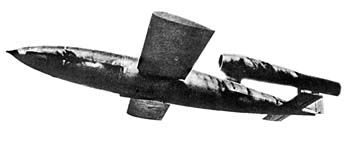 Fieseler Fi 103, FZG 76 http://www.warbirdsresourcegroup.org
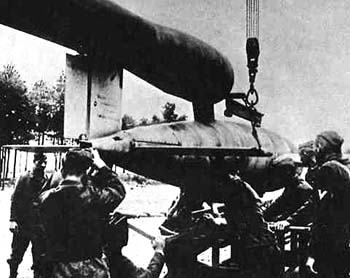 Loading the Fieseler Fi 103, FZG 76 onto its launch ramp citation tba
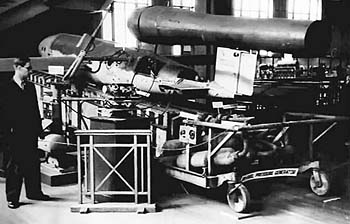 Fieseler Fi 103, FZG 76 on (postwar?) display. Rear view showing mobile launch trolley and supply equipment http://www.warbirdsresourcegroup.org
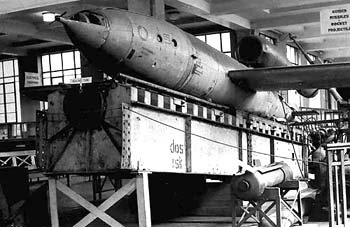 Fieseler Fi 103, FZG 76 (as above). Front view showing mobile launch ramp http://www.warbirdsresourcegroup.org
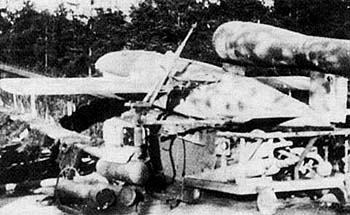 Fieseler Fi 103, FZG 76 on mobile launch ramp (wartime image) citation tba
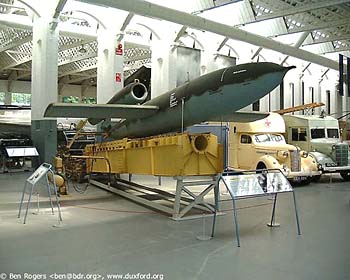 Fieseler Fi 103, FZG 76, (as above). On a mobile launch ramp - today http://www.duxford.org/exhibits/hangar1/exhibits/
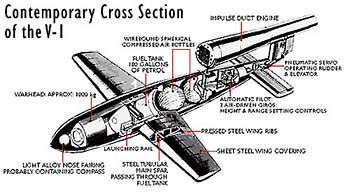 Fieseler Fi 103, FZG 76, c.1942 citation tba
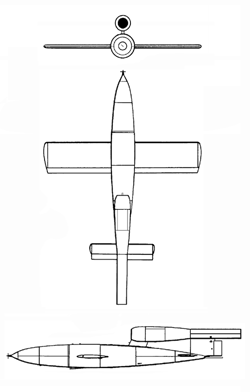 Fieseler Fi 103, FZG 76 3View citation tba
 Fieseler Fi 103, FZG 76 and its later manned version the Fi 103R Designed to attack high-precision targets, the Fi 103R would plunge into a dive towards the target, the pilot bailing out at the last moment. The project was deemed impractical and abandoned.
http://home.inreach.com/rickylaw/dictatorship/wonder/missile/v-1/v-1.html
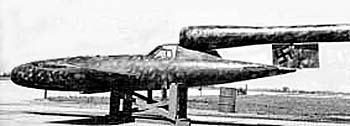 Fi 103R citation tba
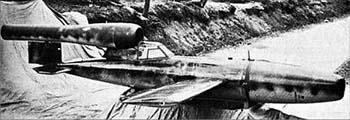 Fi 103R citation tba
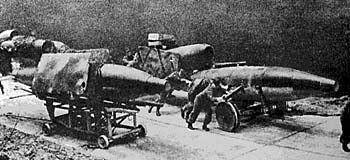 Fieseler Fi 103, FZG 76 missiles, c.1942 citation tba
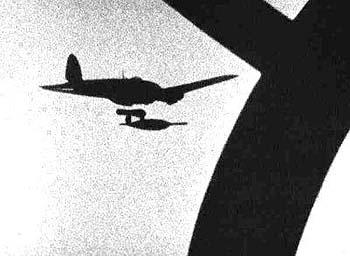 Fieseler Fi 103, FZG 76 air launched from Heinkel III
http://home.inreach.com/rickylaw/dictatorship/wonder/missile/v-1/v-1.html
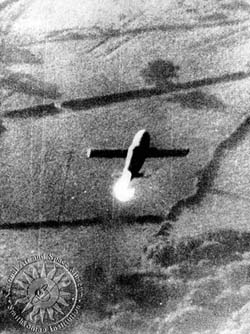 Fieseler Fi 103, FZG 76 Smithsonian
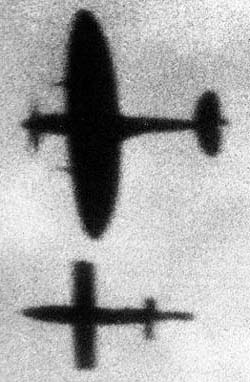 Spitfire intercepting a Fieseler Fi 103, FZG 76
http://home.inreach.com/rickylaw/dictatorship/wonder/missile/v-1/v-1.html
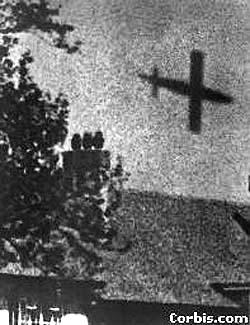 Fieseler Fi 103, FZG 76 final moments before impact
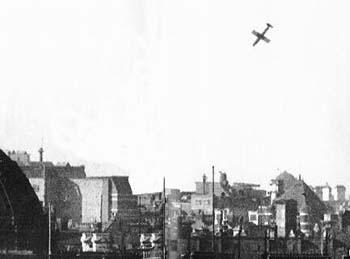 Fieseler Fi 103, FZG 76 final moments before impact http://www.accessweb.com/users/mconstab/v1.htm
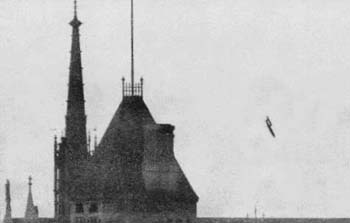 Fieseler Fi 103, FZG 76 final moments before impact British Ministry of Defence
 Fieseler Fi 103, FZG 76 on impact British Ministry of Defence
Further Reading
Fieselier Fi 103, FZG 76 'Vengence Weapon'
The V1 Missile
Fi-103, FZG 76 Surface-to-Surface Cruise Missile 1942, 1944-1945
V1 Missile - Description
V2, A4 Short Range Ballistic Missile 1938, 1944-45
Les missiles du IIIème Reich - In French
Vergeltungswaffe V1 - In German
|
© Copyright 1999 CTIE - All Rights Reserved - Caution |
 Engelmann, Joachim, V1 - The Flying Bomb
Engelmann, Joachim, V1 - The Flying Bomb